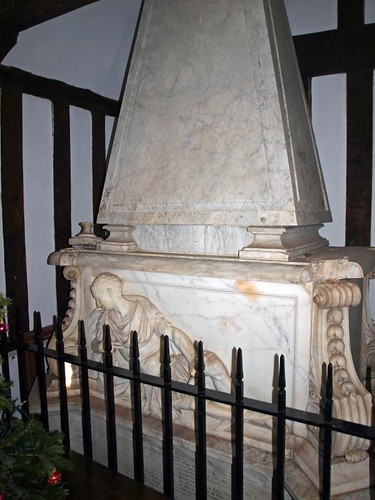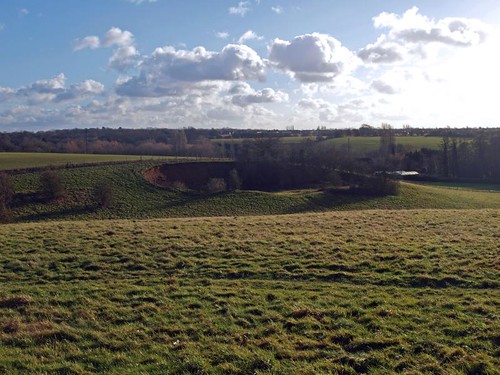It has to be said, however, that it's not particularly interesting; I think it's the locale, an ancestral connection and the fact that it was old, open, light and it was finally sunny so it could have been simply a 'good' church.
ST PETER. A small church on the edge of a scattered village but with the RECTORY close by, a five-bay, two-storeyed Georgian house with a timber-framed weatherboarded barn, and a stable also timber-framed but with brick infillings. - The church is partly still of the C11 (see a tiny window on the N side of the nave and the uncovered remains of inner surrounds of windows on the S side). The chancel was rebuilt or remodelled in the C13, as is proved by S lancet windows. Also of the C I 3 the S aisle with lancet windows and an arcade of octagonal piers with simply moulded capitals. Of the C15 some inserted Perp windows, the whole very low W tower with diagonal buttresses and a spike, and the nave roof. A little later still the timber S porch, badly converted, when the chief monument of Tewin was removed from its original place outdoors and squeezed into the porch. As this has a high obelisk as its main motif, the effect is painful. The MONUMENT is to General Joseph Sabine, Governor of Gibraltar, d. 1739. Below the obelisk on the pedestal in the front an exquisitely carved relief of a Roman general (portrait ?); on the sides and back trophies and arms. There is a number of good epitaphs in the church (1709, 1727, 1733, 1789) and also a BRASS: Thomas Pygott d. 1610 (S aisle).- FONT. Fluted C18 bowl.
Tewin. It was the Saxons who first penetrated the forest and settled in this clearing. Now, among woods and commons, with sloping fields, narrow lanes, and winding paths, Tewin is a centre for lovely walks in unspoiled country, not an hour’s ride from London.
It has two greens, most of the village lying round the lower one, while the church is half a mile away in the fields. The hand of the Saxon helped to build the walls, but the oldest part of what we see is a Norman nave under a 15th-century timber-and-plaster roof, with one blocked window taking us back nearly to the Conquest, and the remains of two clerestory windows added 700 years ago, when the nave arcade was built. The chancel is 13th century. The spiked tower came late in the 15th. Five of the bells are nearly 300 years old, and a sundial from the days before village clocks is scratched on a corner of the chancel. There is an Elizabethan silver chalice.
In front of the altar is a stone carved about 1356 to the memory of a rector, Walter de Louthe, and a small brass shows us Thomas Pygott, who died in 1610, when his family had been in Tewin 300 years. There is a monument to Josephine Sabine, a General who fought under Marlborough and was Governor of Gibraltar. He died out there and was brought home for burial here. His marble monument, 15 feet high, shows the General, dressed in Roman armour, lying in front of a pyramid. Here, too, is a tablet to a queer adventurer, Lady Cathcart, who inscribed on her ring when marrying her fourth husband: “If I survive I’ll make it five.” Number Four took her to Ireland and kept her a prisoner there for 20 years while he spent her money and sold her lands. He died when she was an old lady of 75 and she went to law, recovered Tewin House and her estates, and died at 97 before she had a chance to make it five.
Her story is true, but not true is Lady Anne Grimston’s whose grave is the great sight of Tewin churchyard. It has been split by ash and sycamore trees, which have broken the stones and crumpled the railings. The legend everybody will tell you here is that Lady Anne was an infidel, and that she declared it as likely that she would rise again as that a tree would grow from her grave. It is not true, for Lady Anne was a lady of deep faith and piety; but it is true that trees have grown from her grave, heaving up the great stone, breaking it into fragments, and tearing up the heavy iron railings so that bits of them are now raised high, embedded in the trunks.
The pleasant 18th-century rectory makes use of a pretty timbered stable and a thatched wooden tithe barn, both from the 17th century. Beyond the upper green stands Queen Hoo Hall, a stalwart Elizabethan house with wide latticed windows looking over the wooded slopes.
It has two greens, most of the village lying round the lower one, while the church is half a mile away in the fields. The hand of the Saxon helped to build the walls, but the oldest part of what we see is a Norman nave under a 15th-century timber-and-plaster roof, with one blocked window taking us back nearly to the Conquest, and the remains of two clerestory windows added 700 years ago, when the nave arcade was built. The chancel is 13th century. The spiked tower came late in the 15th. Five of the bells are nearly 300 years old, and a sundial from the days before village clocks is scratched on a corner of the chancel. There is an Elizabethan silver chalice.
In front of the altar is a stone carved about 1356 to the memory of a rector, Walter de Louthe, and a small brass shows us Thomas Pygott, who died in 1610, when his family had been in Tewin 300 years. There is a monument to Josephine Sabine, a General who fought under Marlborough and was Governor of Gibraltar. He died out there and was brought home for burial here. His marble monument, 15 feet high, shows the General, dressed in Roman armour, lying in front of a pyramid. Here, too, is a tablet to a queer adventurer, Lady Cathcart, who inscribed on her ring when marrying her fourth husband: “If I survive I’ll make it five.” Number Four took her to Ireland and kept her a prisoner there for 20 years while he spent her money and sold her lands. He died when she was an old lady of 75 and she went to law, recovered Tewin House and her estates, and died at 97 before she had a chance to make it five.
Her story is true, but not true is Lady Anne Grimston’s whose grave is the great sight of Tewin churchyard. It has been split by ash and sycamore trees, which have broken the stones and crumpled the railings. The legend everybody will tell you here is that Lady Anne was an infidel, and that she declared it as likely that she would rise again as that a tree would grow from her grave. It is not true, for Lady Anne was a lady of deep faith and piety; but it is true that trees have grown from her grave, heaving up the great stone, breaking it into fragments, and tearing up the heavy iron railings so that bits of them are now raised high, embedded in the trunks.
The pleasant 18th-century rectory makes use of a pretty timbered stable and a thatched wooden tithe barn, both from the 17th century. Beyond the upper green stands Queen Hoo Hall, a stalwart Elizabethan house with wide latticed windows looking over the wooded slopes.



No comments:
Post a Comment